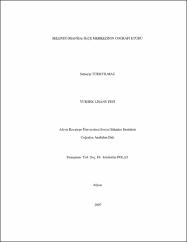Selendi (Manisa) İlçe Merkezinin Coğrafi Etüdü
Citation
Türkyılmaz Şuhayip ''Selendi (Manisa) İlçe Merkezinin Coğrafi Etüdü'' ''Geographical Study Of City Centre Of Selendi (Manisa)''Afyon Kocatepe Üniversitesi Afyonkarahisar 2007Abstract
Araştırma konumuzu oluşturan Selendi İlçesi, Ege Bölgesi’nin İç Batı Anadolu Bölümü’nde, Manisa İli sınırları içinde yer almaktadır. Yönetim açısından Manisa İli’ne bağlı olmasına rağmen, Manisa İl merkezine 162 km.’dir. İlçeyi, doğu ve güneydoğusunda Uşak İli, güney ve güneybatısında Manisa’nın Kula İlçesi kuzey ve kuzeybatıda Manisa’nın Demirci İlçesi ve kuzey, kuzeydoğuda Kütahya İli’nin Simav İlçesi çevrelemektedir.
Selendi İlçe merkezi 233,7 hektar alana sahiptir. İlçenin beldesi yoktur. İlçe merkezine bağlı 11 mahalle ve 44 köyü vardır. Köylerin çoğunluğu dağınıktır. 30 köyün 115 mahallesi vardır. 2000 yılı genel sayımı sonuçlarına göre, ilçe merkezinin nüfusu 8095 kişi, köyleriyle birlikte toplam nüfusu 26061 kişi idi. İlçe göç veren bir yerleşim birimidir. Sahada ekonomik ve kültürel faaliyetlerin çeşitlenerek gelişmesi, dışarıya olan nüfus hareketlerini azaltacak, yörenin kalkınmasını hızlandıracaktır. İlçenin çevresi dağ ve tepelerle çevrilidir. İlçe merkezi, Selendi Çayı Vadisi’nde kurulmuştur. İlçenin içinden Gediz Nehri’nin en büyük kolu olan, Selendi Çayı geçmektedir. Rakımı 440 metredir. Arazi genellikle dağlık, vadilik ve kısmen de ovalıktır.
Araştırma sahası, Akdeniz ile karasal iklim arasında geçiş özelliği gösteren yarı kurak- yarı nemli, ılıman bir iklim hüküm sürmektedir. Kurak - az nemli, mezotermal ( orta sıcaklıkta) su fazlası kış mevsiminde ve çok kuvvetli olan, okyanus tesirine yakın(?) iklim tipine girmektedir.
Çalışma alnında temel ekonomik etkinlik tarım ve hayvancılıktır. Ticaret ve sanayi gelişme aşamasındadır. İlçe turizm açısından önemli bir potansiyele sahip değildir.
Selendi, E-23 (İzmir- Ankara) karayolunun Kula- Uşak hattı arasında ve 16 km. kuzey yönünde içeride kalmaktadır. Bu da ilçede aktivite azlığını doğurmuştur. Selendi bağlı olduğu il merkezi Manisa’ya 162 km. gibi uzak bir mesafedeyken Uşak merkeze 65 km. gibi daha yakın bir mesafededir.
Ülkemizde, Selendi gibi ekonomik ve sosyal açıdan gelişememiş kırsal, kasaba görünümlü birçok yerleşim merkezleri vardır. Ülkemiz genelinde çok olan bu tür yerleşmelerin coğrafi bir bakış açısıyla da incelenmeleri, sorunlarının tespit edilmesi, çözüm önerilerinin getirilmesi ve kalkınma planlarının hazırlanması bakımından büyük yararlar sağlayacaktır. Bu tip yerleşme yerlerinin böyle çalışmalarla daha iyi durumlara geleceği düşünülerek, Selendi İlçe merkezinin coğrafi etüdü çalışılmıştır.
İlçe göç veren bir yerleşim birimidir. Sahada ekonomik ve kültürel faaliyetlerin çeşitlenerek gelişmesi, dışarıya olan nüfus hareketlerini azaltacak, yörenin kalkınmasını hızlandıracaktır. The city of Selendi which is the subject of our research is in the borders of Manisa which is located in the west part of Aegean Region.
The city which is administratively dependent to Manisa is 162 kms far to the city centre of Manisa. It is surrounded by Uşak in the East and Southeast the city of Kula of Manisa in the South and Southwest, the city of Demirci of Manisa in the North and Northwest and the city of Simav of Kütahya in the North and Northeast.
The city centre of Selendi has an area of 233,7 hectares. There aren’t any smaller cities dependent to Selendi. There are 11 wards and 44 villages which are dependent to Selendi. Most of villges are scattered. There are 115 wards of the 30 villages . According to the 2000 census, the population of the city centre is 8095 people, and the total population of the city with its villages is 26061 people. The city is a “migrating - from” settlement. Developing of the varied economical and cultural activities in the area will reduce the population movement out of the city and will quicken the development of the neighbourhood. The city is surrounded with mounts and hills and was founded in the Valley of Selendi Stream. Selendi Stream which is the biggest baranch of Gediz River passes through the city. The elevation of the city is 440 meters. The land is generally mountainous, having valleys and partly having plains.
The research area has a half dry - half moist, mild climate which shows a transition characteristic between the Mediterranean and continental climates. It is a type of dry - low moist, mezotermal ( medium heat)(the excess of water is in Winter season and very strong) near to ocean effect climate.
In the research area, the main economical activities are agriculture and stock - breeding. Trade and industry are in progress. The city hasn’t got a considerable tourism potantiel.
Selendi is located between Kula - Uşak line of E - 23 ( İzmir - Ankara) road and it is 16 kms interior in the North direction. This caused the lack of activity in the city. Although Selendi is in a long distance of 162 kms to the city centre of Manisa where it is administratvely dependent, it is nearer to the city centre of Uşak such as 65 kms.
In our country, there are a lot of settlement areas which haven’t developed economically and socially, in the appearance of rural small town like Selendi. Examining also geographically of this kind of settlements which are generally a lot in our country will provide big advantages in finding out the problems, giving solution suggestions and preparing of development plans. Believing that this kind of settlements wich have been out of sight, will become better by the help of studies like this, the geographical research of the city centre of Selendi has been studied.
The city is a migrating - from settlement. The development of economical and cultural activites in the area varidly will reduce the population movement out of town and will quicken the development of the area.
Collections
- Yüksek Lisans Tezleri [1638]



















